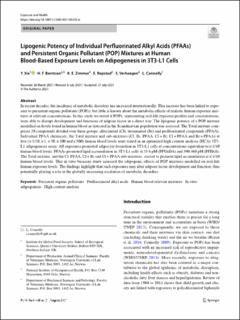Lipogenic Potency of Individual Perfuorinated Alkyl Acids (PFAAs) and Persistent Organic Pollutant (POP) Mixtures at Human Blood‑Based Exposure Levels on Adipogenesis in 3T3‑L1 Cells
Xie, Y.; Berntsen, Hanne Friis; Zimmer, Karin Elisabeth; Ropstad, Erik; Verhaegen, Steven; Connolly, L.
Peer reviewed, Journal article
Published version
Permanent lenke
https://hdl.handle.net/11250/2832790Utgivelsesdato
2021Metadata
Vis full innførselSamlinger
Originalversjon
10.1007/s12403-021-00420-wSammendrag
In recent decades, the incidence of metabolic disorders has increased internationally. This increase has been linked to exposure to persistent organic pollutants (POPs), but little is known about the metabolic efects of realistic human exposure mixtures at relevant concentrations. In this study we tested if POPs, representing real-life exposure profles and concentrations, were able to disrupt development and functions of adipose tissue in a direct way. The lipogenic potency of a POP mixture modelled on levels found in human blood as detected in the Scandinavian population was assessed. The Total mixture comprises 29 compounds divided over three groups: chlorinated (Cl), brominated (Br) and perfuorinated compounds (PFAA). Individual PFAA chemicals, the Total mixture and sub-mixtures (Cl, Br, PFAA, Cl+Br, Cl+PFAA and Br+PFAA) at fve (×1/10,×1,×50,×100 and×500) human blood levels were tested in an optimized high content analysis (HCA) 3T3- L1 adipogenesis assay. All exposures promoted adipocyte formation in 3T3-L1 cells at concentrations equivalent to×1/10 human blood levels. PFAAs promoted lipid accumulation in 3T3-L1 cells at 33.6 pM (PFUnDA) and 390,460 pM (PFHxS). The Total mixture, and the Cl, PFAA, Cl+Br and Cl+PFAA sub-mixtures, started to promote lipid accumulation at×1/10 human blood levels. This in vitro bioassay study assessed the adipogenic efects of POP mixtures modelled on real-life human exposure levels. The fndings highlight that such exposures may alter adipose tissue development and function, thus potentially playing a role in the globally increasing escalation of metabolic disorders.
